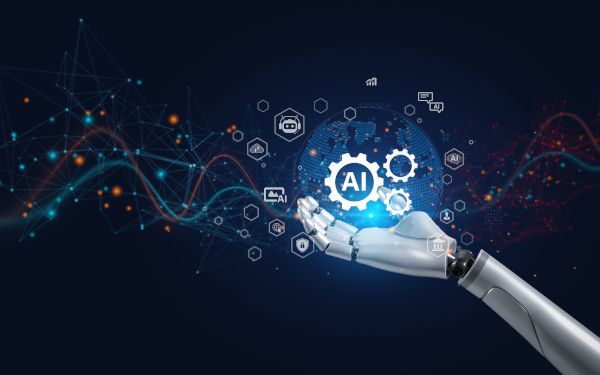At the start of the year, Intrada Technologies partnered with the Pennsylvania State Association of Township Supervisors (PSATS) to present an engaging and informative webinar. The session focused on how township supervisors and local government officials can leverage tools like Microsoft 365 and AI...
Understanding Generative vs. Agentic AI: Transforming Workplaces Today
Overview
Microsoft Power Platform is a powerful suite of tools that enables businesses to modernize operations by automating workflows, streamlining processes, and building applications with minimal coding expertise. By leveraging its low-code/no-code environment, seamless integration with Microsoft and third-party applications, and empowering citizen developers, organizations can reduce costs, enhance efficiency, and adapt to evolving business needs.
Overview

Artificial intelligence (AI) is transforming modern businesses by streamlining processes, fostering creativity, and driving innovation. By understanding tools like generative AI for content creation and agentic AI for automation, companies can enhance efficiency while empowering their workforce to focus on strategic, high-value tasks.
IN DEPTH
Artificial intelligence (AI) is key in reshaping how businesses operate today. From creative brainstorming to data-driven decision-making, AI solutions are helping companies unlock new levels of efficiency and innovation. But with terms like "Generative AI" and "Agentic AI" being thrown around, it can feel overwhelming to understand what these tools mean and how they fit into your business strategy.
This article will help you understand these AI concepts and explore their roles in the modern workplace. You'll learn how technologies like ChatGPT, Jasper, Gemini, and Copilot are actively transforming business operations while highlighting the importance of data and the irreplaceable role employees play in AI-driven workflows.
The AI Hype in the Workplace
AI has been making waves across industries, with predictions that it will revolutionize everything from customer service to manufacturing. However, AI's excitement must be balanced with an understanding of its capabilities and limitations. AI is not a magic wand, nor is it here to replace humans. Instead, AI is a tool that works in partnership with people, enabling teams to achieve more together.
The phrase "AI won't replace employees, but employees who use AI will replace those who don’t" remains a compelling argument for thoughtfully adopting AI. Ignoring AI technologies could mean falling behind competitors who leverage their potential to enhance productivity and innovation.
But first, understanding what types of AI exist and how they function is key to leveraging them effectively.
What Is Generative AI?
Generative AI involves systems like ChatGPT, Jasper, and Gemini that can produce creative outputs, such as text, images, and even entire video scripts. These tools rely on advanced algorithms trained on a vast data pool to generate ideas, write articles, or design visuals. They’re ideal for tasks where creativity or original content creation is needed.
How Generative AI Applies to Businesses
- Content Creation: Marketing teams use tools like Jasper to craft engaging captions, blog posts, and ad copy without starting from scratch.
- Customer Support: Virtual assistants powered by generative AI can provide detailed responses to customer queries, streamlining service without losing the human touch.
- Product Design: Generative models can create mockup designs or prototypes, accelerating product development cycles.
Example: A retail company uses ChatGPT integrated with its CRM system to personalize customer email messages based on purchase history, improving open rates and customer engagement.
What Is Agentic AI?
Agentic AI refers to systems capable of autonomous actions based on real-time data, goals, and context. Unlike generative AI, which focuses on creating, agentic AI revolves around decision-making and task automation. Microsoft’s Copilot and similar AI tools fall into this category.
How Agentic AI Applies to Businesses
- Supply Chain Management: Agentic AI can monitor inventory levels and automatically reorder stock when running low, reducing manual intervention.
- Data Analysis: Businesses deploy tools like Copilot to identify actionable insights from raw datasets, making reporting and forecasting more efficient.
- Cybersecurity: Agentic AI systems quickly detect and respond to threats in real-time, safeguarding sensitive business data.
Example: A logistics company employs a digital assistant powered by agentic AI to optimize delivery routes. By analyzing live traffic data, the system optimizes routes to achieve faster delivery times while reducing fuel consumption. This approach not only enhances efficiency but also contributes to more sustainable operations, benefiting both businesses and the environment.
Why Data Is the Lifeblood of AI Systems
Whether you’re leveraging generative or agentic AI, its effectiveness hinges on one critical factor: data quality. Insufficient data leads to flawed outputs, while rich, accurate data proves reliable results. Before implementing any AI tool, it is essential to evaluate your datasets for consistency, relevance, and accuracy.
Example mistakes businesses make include:
- Using incomplete data sets for training models results in biased AI-generated outputs.
- Ignoring regular updates to the data that AI systems rely on for decision-making.
Start small. Test AI tools with focused datasets to uncover their potential and limitations for your specific industry needs.
AI Complements Your Workforce; It Doesn’t Replace It
Automation is powerful but is no substitute for human creativity, emotional intelligence, and strategic thinking. While AI excels at handling repetitive tasks or analyzing vast amounts of data, human expertise remains critical in interpreting outcomes, making decisions, and fostering relationships.
Businesses that succeed with AI focus on upskilling their teams and integrating AI as a collaborative partner rather than a replacement. For example:
- Marketing teams use Jasper to speed up content brainstorming while retaining creative control over final drafts.
- Data analysts deploy Copilot to crunch numbers, giving them more time to interpret findings and recommend actionable strategies.
Bringing AI Into Your Business Strategy
Implementing AI doesn’t start by buying the trendiest tool on the market. Instead, it starts by identifying specific business pain points and assessing whether AI solutions align with your goals. Are your customer queries overwhelming your support team? A generative AI-powered chatbot might help. Are you struggling with supply chain inefficiencies? Look into agentic AI for automation.
Steps to Integrate AI in Your Workplace
- Analyze Needs: Review areas where workflows can be optimized.
- Evaluate Tools: Research tools like ChatGPT, Jasper, Gemini, or Copilot to see which aligns best with your business functions.
- Pilot Programs: Implement AI on a smaller scale to test its impact before rolling it out company-wide.
- Train Employees: Offer training on how to use AI tools effectively—not just technically, but strategically.
When you adopt AI with a purposeful strategy, it can help your team unlock heightened productivity and strategic insight, better equipping your business to tackle new challenges.
Take the Next Step in Your AI Journey
AI isn’t about replacing your teams; it’s about empowering them. Generative and agentic AI are tools that, when paired with human creativity and expertise, can redefine what’s possible for your business.
If you’re ready to explore how AI can enhance your operations, we’re here to help. Consider Intrada Technologies as part of your extended IT or marketing team. With over 25 years of experience, we work with businesses to select and implement the tools that matter most.
Start with a conversation today.
What’s New with Google Analytics?
Google Analytics (GA) is like the internet’s Sherlock Holmes for businesses—it uncovers the critical clues you need to understand your audience and refine your strategy for success. GA has become very important for marketers and business owners in making data-driven decisions that fuel growth and in...
Contact Us
- 800-858-5745
31 Ashler Manor Drive
Muncy, PA 17756
Office Hours
Monday - Friday
8 AM - 5 PM EST
Intrada Technologies


Copyright © 2025 - Intrada Technologies - Privacy Policy and Disclaimer
Our website uses cookies and analytics to enhance our clients browsing experience. Learn More /
